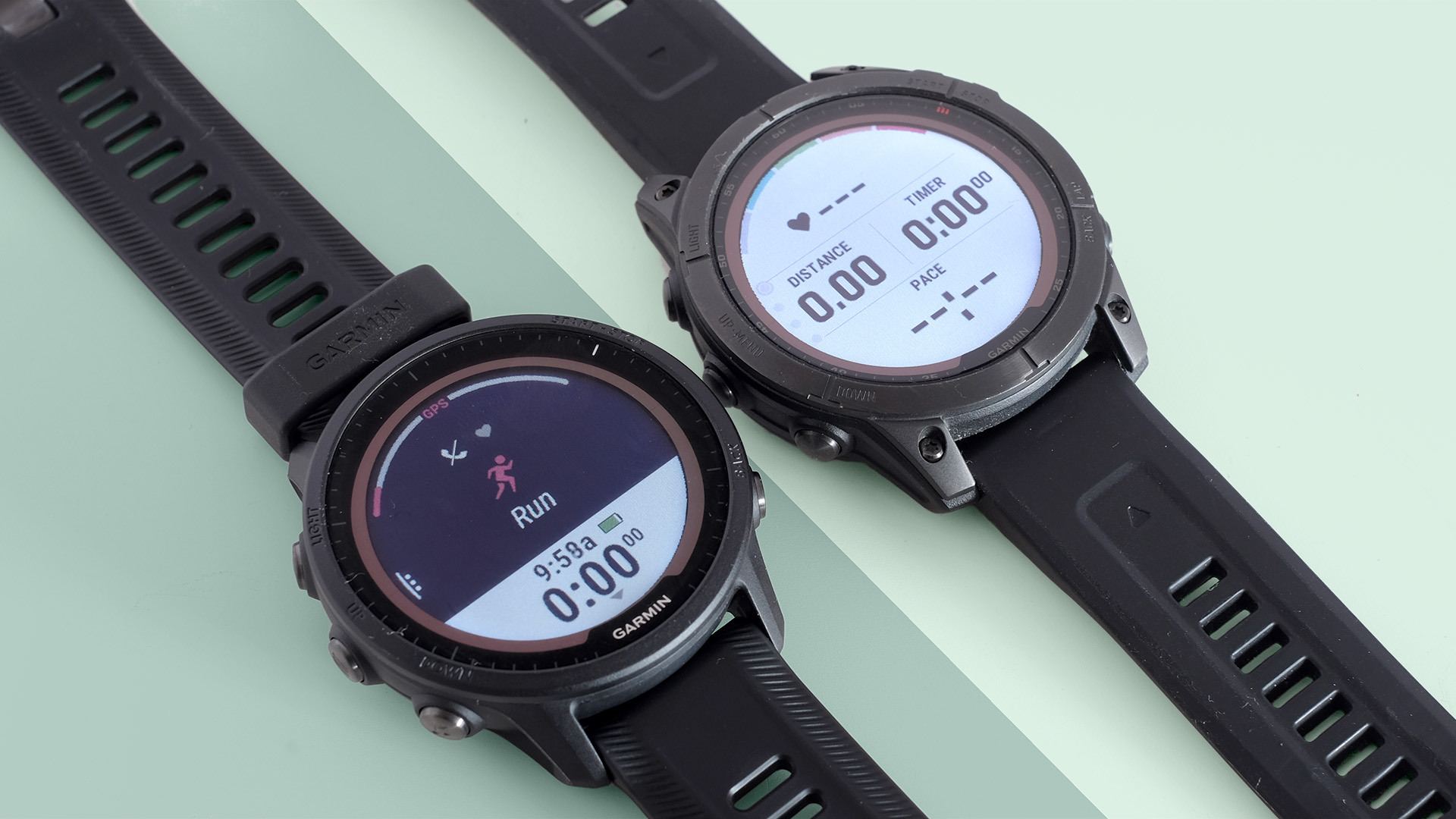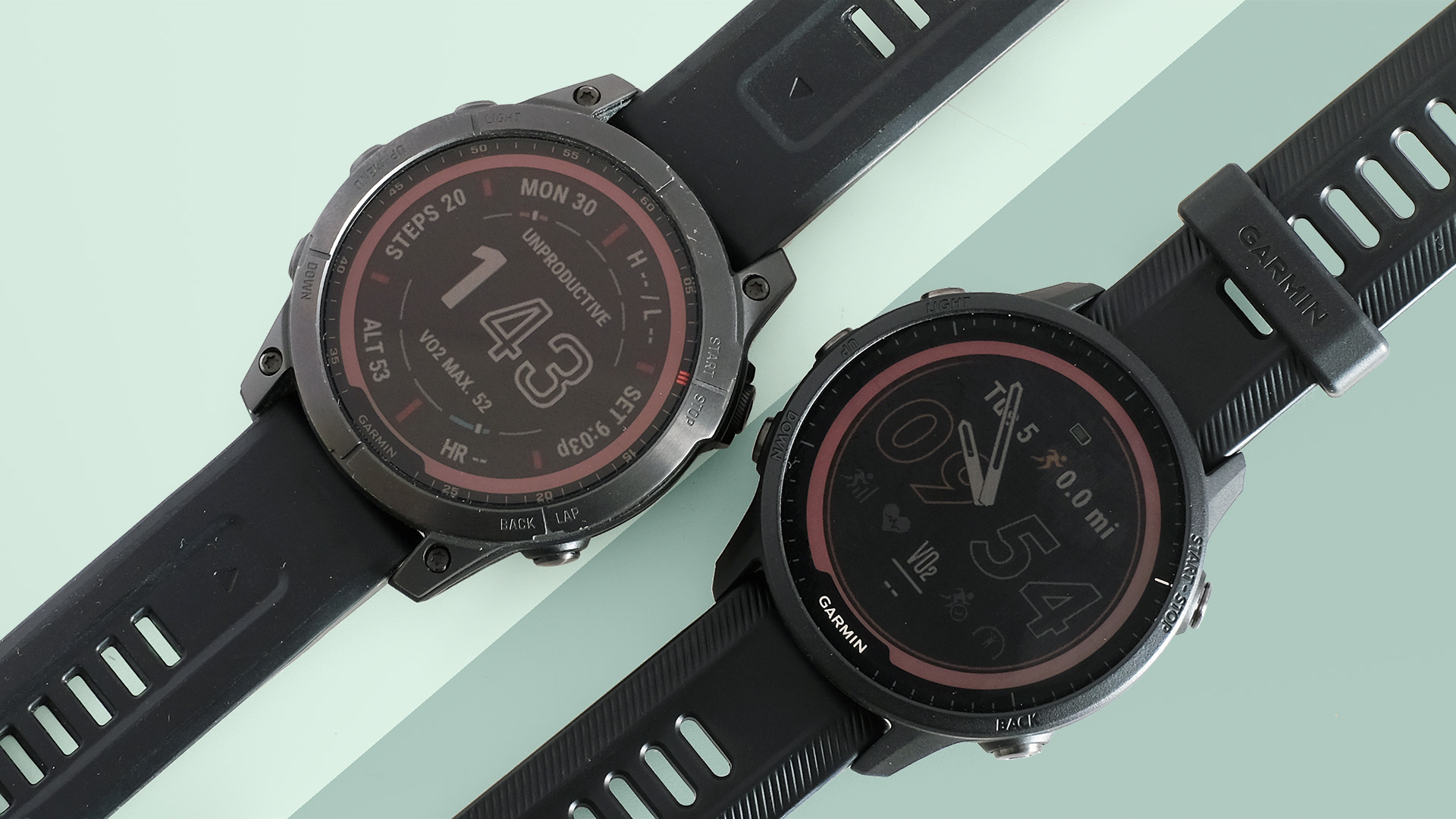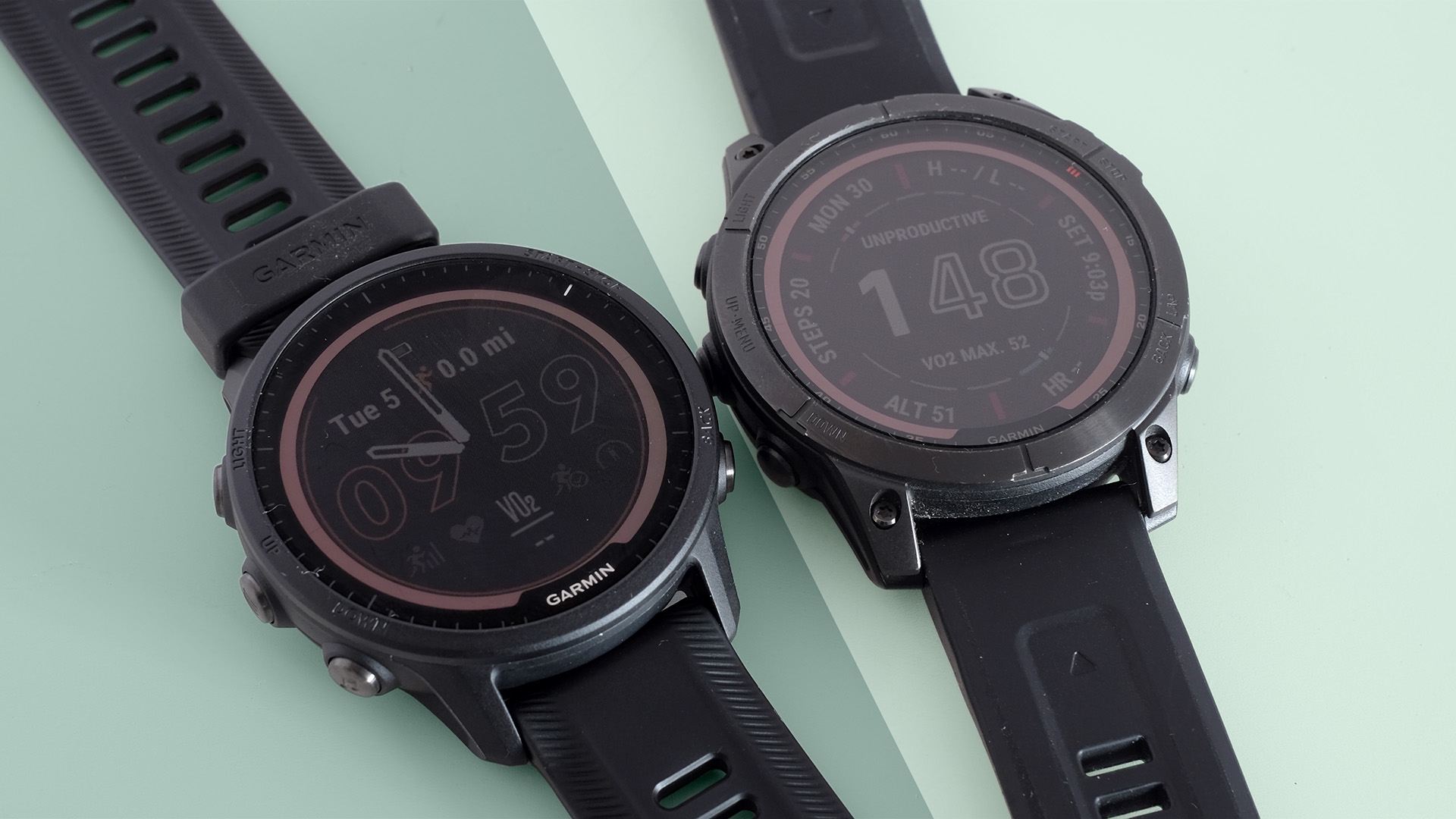Garmin Forerunner 955 vs Garmin Fenix 7: Which running watch is right for you?
Can the new Garmin Forerunner 955 knock the Garmin Fenix 7 off its perch?

The Garmin Forerunner 955 vs Garmin Fenix 7: two of the best Garmin watch entries and high-end multisport fitness watches. They are fairly similar, and stacked with so many features it’s hard to imagine one person using them all.
There are a few differences between these two, though. The Fenix 7 costs a little more and has either a stainless steel or titanium bezel and backplate. You can check out our full hands-on Garmin Forerunner 955 review for an early verdict, but the Forerunner is a little cheaper and uses tough plastic, which is less hard. This reduces weight significantly, though, making the watch more comfortable to wear 24/7.
The Garmin Forerunner 955 also debuts a few new athlete-ready features like HRV Status, Training Readiness, and Race Calendar. However, we would not be surprised if these are added to the Fenix 7 in a future software update.
This is ultimately a fairly simple decision. Do you want to spend perhaps $100 more for a harder, more serious-looking stainless steel bezel, and accept a little extra weight as part of the deal?
The Fenix 7 and Forerunner 955 are otherwise similarly capable high-end fitness watches, and you can’t go far wrong with either.
Garmin Forerunner 955 vs Garmin Fenix 7: Price and Availability
The Garmin Forerunner 955 is a little cheaper than the Fenix 7. Garmin may dress up the differences in these two models in other ways, but saving a little money is the number one reason to pick a Forerunner over the Fenix.
There are two versions of the Forerunner 955. The standard watch costs $499.99/£479.99, the solar charging Power Glass model is $599.99/£549.99.
The Fenix 7 costs $699/£599 for the standard model, $799/£689 for the solar version and $899/£779 for the Sapphire Solar with extra-hard glass. You save around $100 in each case.
These two watch series are part of the same generation, but the Fenix 7 arrived earlier. It landed in January 2022, while the Forerunner 955 in June 2022.

Garmin Forerunner 955 vs Garmin Fenix 7: Design and display
- The Forerunner 955 has a plastic “resin” bezel, the Fenix 7 a steel one
- Metal makes the Fenix 7 noticeably heavier
- The displays are very similar, but the top-end Sapphire Solar Fenix is more reflective
Core design differences are much the same as they were in the last generation, when the Fenix 6 and Forerunner 945 competed for your cash. The two watches look, and are, somewhat similar, but the materials used are not the same.
The Fenix 7 has either a stainless steel or titanium bezel and rear casing, the Forerunner 955 a tough plastic resin shell. It’s what makes the Fenix 7 slightly higher-end, and also slightly heavier.
No-one’s going to call the Forerunner 955 a no-frills fitness watch, but its use of plastic is pragmatic and value-led. Taking out our scales for a closer look, the Forerunner 955 Solar weighs 53g, to the 72g of our Garmin Fenix 6 Solar Titanium.
The benefit of lower weight was immediately apparent during our first tracked run with the Forerunner 955. It tries to move about on your wrist less, as that resin shell just can’t mount that much momentum. Less movement means you need to worry less about having the strap extra-tight for good HR results, and on some wrists it may make HR readings during exercise slightly more consistent.
You don’t get a choice of sizes with a Forerunner 955, though. The watch face measures just over 47mm in diameter, just like the standard Fenix 7. However, the Fenix range is bulked up with Fenix 7S and Fenix 7X watches. The “S” has a smaller 42mm face, the “X” a giant 51mm one.
All versions of both families use the same core display tech, the MIP LCD. Owners of older Garmin watches will be familiar with this style. It looks superbly clear outdoors on bright days, and uses a front light to illuminate the screen in the dark because the panel is not backlit like a standard LCD or OLED.
Display resolutions of the 47mm Fenix 7 and Forerunner 955 are the same too — 260 x 260 pixels. If a screen with relatively dull color and contrast (but great outdoors clarity) doesn’t appeal, you don’t want either of these watches but a Garmin Venu 2 or Garmin Epix instead. They have OLED panels.
However, the Forerunner 955 shares the same big usability change introduced in the Garmin Fenix 7 and Epix. These latest-generation watches have touchscreens, but unlike other Garmin touchscreen watches, they also have the classic array of physical buttons.
By default the touchscreen is disabled during tracked activities, to avoid accidental registered taps and swipes. In typical Garmin fashion, you have full control, though. The touchscreen can be fully disabled across the interface, and toggled separately in and out of tracked exercise sessions.
The first thing we noticed when directly comparing our Fenix 7 Sapphire Solar and Foreunner 955 Solar was contrast. It may sound surprising but Garmin’s standard Power Glass leads to better indoors screen clarity and deeper blacks than Power Sapphire, seen in the top-end Fenix 7 Sapphire Solar.
This is not a knock on the Fenix 7, though. The “standard" Fenix 7 Solar uses Power Glass, not Power Sapphire. This is something to bear in mind if you’re tempted by the top-end Sapphire Solar version. It may be more scratch resistant, but does not have the anti-reflective coating of standard Power Glass, which is produced by Corning, maker of the Gorilla Glass used in most great phones.

Garmin Forerunner 955 vs Garmin Fenix 7: Battery Life
- Both watches can last up to several weeks between charges
- The Fenix 7 has a slight edge for battery life
- Both are charged using Garmin’s long-standing four-pin cable
These watches are both very long-lasting by smartwatch standard, but the Fenix 7 has a slight edge for stamina. Garmin rates the Forerunner 955 Solar at 20 days of use between charges, if it gets three hours of decent sunlight a day. The Fenix 7 is pegged at 22 days in the same conditions.
Garmin says the Forerunner 955 Solar lasts up to 49 hours of constant GPS tracking, and the Fenix 7’s figures vary wildly depending on the mode used. Using all GPS satellite bands you’ll get around 40 hours with the standard Fenix 7, 48 with the Fenix 7 Solar. It increases to 57 (standard) or 73 (Solar) hours when only using the US’s GPS satellite array.
Given we’re talking about more than a week of real-world use with several long GPS-tracked runs, the disparity here is unlikely to seem too huge in person.
Garmin Forerunner 955 vs Garmin Fenix 7: Fitness tracking
- The Forerunner 955 adds HRV Status
- Body Battery is complemented with Training Readiness in the Forerunner 955
- Their abilities are ultimately very similar
The Fenix 7 and Forerunner 955 are similarly powerful fitness watches. They can both do advanced things like controlling smart turbo trainers, they’ll connect to external Bluetooth or ANT+ sensors and let you download maps for full offline navigation.
Garmin has introduced a few new software features in the Forerunner 955. These are not present in the Fenix 7 at the time of writing, but it is likely at least some of them will come to the Fenix 7 in a software update. There’s no technical reason to stop this happening, and as they are part of the same generation the Fenix 7 arguably deserves them.
HRV Status is the most useful of these for the average fitness tracker buyer. It sees heart rate variability given much greater prominence in that stats you can access each day.
Until quite recently, you needed a chest strap HR sensor to actually see HRV results. This changed with the latest generation of watches, which display HRV scores in the Health Snapshot mode. It takes two minutes and asks you to sit still the whole time — not that appealing for everyday use.
The Forerunner 955 adds HRV Status. This records your hart rate variability overnight. When you open up the HRV widget on the watch itself, you’ll see a graph of the results. Its presentation is similar to that of a heart rate reading during exercise.
During sleep is the most practical time to record heart rate variability as it is a far more sensitive metric than heart rate, which remains useful as long as it is within a few bpm. HRV scores end up as an average of the difference in milliseconds between heart beats during your sleep — a greater average disparity is better as it suggests your cardiovascular system is more adaptable.
HRV also feeds into another new Forerunner 955 feature, Training Readiness. This estimates, just as the name suggests, how ready for you are for a workout. It’s the athlete’s take on Body Battery, the alternative our Fenix 7 has at the time of writing (the Forerunner 955 has Body Battery too).
The two, quite honestly, seem pretty similar from where we’re standing. They give you a score out of one hundred based on your sleep, stress, and how much exercise you’ve done in the last day or so. The presentation is a little different, though.
Body Battery feels made for Garmin’s mass-market watches, a way to see if you’re getting enough quality sleep. Training Readiness breaks things down further, with separate fields for Acute Load, Recovery Time and its other constituent metrics. It’s a reaction to wearables like the Whoop band, which is almost solely focused on recovery and training optimization.
The final notable Forerunner 955 addition is another athlete’s feature called Race Calendar. You input your races, or the dates of upcoming events like triathlons, half marathons, charity 10km runs and so on, in the Garmin Connect app. The Race Calendar widget then shows you a countdown, expected weather reports, and this also feeds into the suggested workouts you’re shown.
Race Calendar and Training Readiness arguably make the Garmin Forerunner 955 a more athlete-focused watch than the Fenix 7, which is unexpected given the Forerunner is slightly cheaper. In our opinion this simply means these additional features are likely to be added to the Fenix 7’s already large widget library in a feature update.
If the Fenix 7 is a serious-enough watch for Garmin’s Training Status feature, it surely also deserves the new Training Readiness one too.
When we first took the Garmin Forerunner 955 our for a run we noticed its info screens were more bare than the Fenix 7’s, with three info panes per screen instead of four. However, this can be tweaked in the watch’s settings menu so is not something that really separates these watches.
Garmin Forerunner 955 vs Garmin Fenix 7: Features
- They have the same core features
- Up to 32GB storage in each case
- The Map Manager
The Forerunner 955 and Fenix 7 are ultimately largely evenly matched. They both use Garmin’s Elevate v4 heart rate hardware, have a barometric altimeter, a temperature gauge and Multi-band GPS. Both have Pulse Ox too, Garmin’s branding of SpO2 blood oxygenation readings.
They have downloadable offline maps too. We initially thought the Forerunner 955 lacked the Fenix 7’s Map Manager, which is where you download new countries’ worth of data, but it has simply been moved. You’ll find it in the main Settings menu, not as a widget sat among the exercise tracking modes.
Our Forerunner 955 Solar has 32GB storage, just like the Fenix 7 Solar, and came with TopoActive Europe maps preinstalled. Both watches also support music streaming, for use with a pair of Bluetooth headphones.
Get daily insight, inspiration and deals in your inbox
Sign up for breaking news, reviews, opinion, top tech deals, and more.
Andrew is a freelance journalist and has been writing and editing for some of the UK's top tech and lifestyle publications including TrustedReviews, Stuff, T3, TechRadar, Lifehacker and others.
